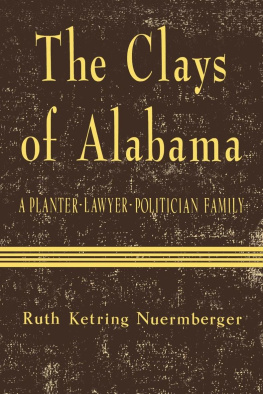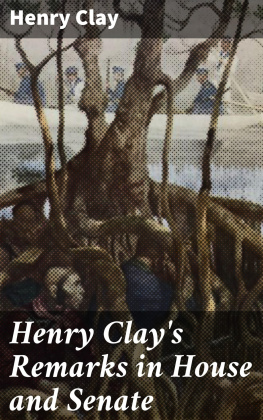PREFACE
RESIDENCE IN THE SOUTH does not guarantee understanding of that region, but it is likely to help. I have enjoyed two salient advantages in the study of southern history: a long residence in the South and a close association with one of the great collections of southern Americana. The graduate student going to a southern university to study southern history not only immerses himself in the Souths past, but is catapulted into the contemporary South with all its changing currents, yet with its viewpoints so distinctive from those of other regions. So it was that I went to Duke University, there to make many southern friends and to try to understand their attitudes, while absorbing facts of the Souths past. Later, as curator of manuscripts in Duke University Library, I had the unparalleled opportunity of viewing the whole kaleidoscope of southern history, as I handled and examined the thousands of manuscripts that poured into the George Washington Flowers Collection.
This study of the Clay family, begun under the late Professor William Kenneth Boyd, was first written as a doctoral dissertation. Since then it has been several times rewritten, with the addition of much new material. Acknowledgments of indebtedness can be only partial, for in the accumulation of a body of historical knowledge, the historian gathers from a multitudinous number of sources, of which books, archives, and manuscripts are only the most obvious.
For specific assistance of various kinds I wish to thank the staff of the Alabama Department of Archives and History; the Stack and Reader Division of the Library of Congress for the use of study facilities; Professor Roy F. Nichols; Dr. Reinhard Luthin; Professor Nannie M. Tilley; Dr. Mattie Russell, present curator of manuscripts at Duke University; Allene Ramage FitzGerald; Elizabeth Montgomery Sloan; and the late Mrs. Bettie V. Adams. To my husband, Gustave A. Nuermberger, I am indebted for sympathetic encouragement and for numerous critical readings of the manuscript.
Washington, D. C.
August, 1957 | R. K. N. |
1

A Plantation on the Frontier
ON A NOVEMBER DAY in 1811, young Clement Comer Clay rode into the rising frontier town of Huntsville. His visible resources were two horses, one Negro servant, a few lawbooks in his saddlebags, and a small amount of money. He was the typical early nineteenth-century young man on the make, come to seek fame and fortune in the West.1 Here he would establish home and family, plantation and slaves; here he would practice law, and serve his section and state in many capacities. From here he would go as a Jackson man to Washington, where, successively as representative and senator, he would work zealously for the Jacksonian program and aid his constituents by obtaining relief legislation for land debtors. There in the next generation his eldest son, as a fiery young senator from Alabama, would lift an eloquent voice in behalf of state rights.
Huntsville lay in the great valley of the Tennessee, at first within the bounds of Mississippi Territory, but soon becoming the northern section of the new state of Alabama. This land into which Clement Comer Clay had come was by report a veritable Garden of Eden where mild climate and wondrously rich soil bestowed indubitable riches. To the immigrant from the East the great valley opened out before his eyes a broad and verdant expanse of plain, bounded by rolling hills and a blue haze of low mountains. From the beginning this geographic curiosity, the Tennessee Valley, played its peculiar part in the life and history of Alabama. In the first place it did not really belong to Alabama, for geographically and economically it was tied to Tennessee and the Upper South rather than to the remainder of Alabama and the Lower South. Furthermore, the valley was always in conflict with itself, for the level portions were in soil and climate elegant cotton country, while the coves, ravines, and hilly terrain were to become the province of the small farmer. The resulting divergence of interests caused strange things to transpire politically, for while the planters soon became the ruling class, their small-farmer constituents often had to be appeased.2
The Tennessee Valley, however, was not all of Alabama. To the southward streached a wild, hilly, desolate, infertile country, depressing to observe and difficult to pass through. This area formed a barrier between North and South Alabama, dividing the state into two great sections which felt alien to each other. The hill country itself was gradually settled by farmer folk of unprosperous and suspicious natures. Central Alabama, with its pine and oak uplands merging into the great cotton-producing Black Belt, was not extensively settled until the years 1830-1850, while the less fertile land toward the Gulf was in general the last section to attract population.3
But soil was not the sole consideration of the pioneer; to him transportation was of equal importance. The first settlers chose the rich river bottoms bordering navigable waters; thus it was that the Tennessee Valley and the Alabama and Tombigbee river lands drew the first accessions of population.4
Only a few islands of settlement yet punctuated the wilderness that had become Mississippi Territory in 1798. Most important were Natchez on the Mississippi and St. Stephens on the Tombigbee. The newest, centered at Huntsville, was in Old Madison County, a triangular area between Tennessees southern boundary and the Great Bend of the Tennessee River, ceded by the Indians in 1806. According to tradition, John Hunt had examined the site of Huntsville in 1805 and had settled there with his family in 1807. He selected his location because of the Big Spring. In that limestone country, springs, actually underground rivers coming to the surface, are a common geologic feature. Such a river wells up beneath a semicircular bluff just west of Huntsvilles public square. For a century and a half it furnished that towns water supply, and today it flows through a beautiful small park. So perfect a source of water naturally attracted settlers. In consequence, the town as well as the county, and, indeed, the entire Tennessee Valley, grew with astounding rapidity in the boom years from 1809 to 1819.5
Madison County, the Indian agent explained in 1809, already had upwards of 2000 Souls who came from the East, West, North, and South and have brot. with them their passions, and there [sic] virtuesWhen civilization and refinement shall be well established, this will be a desirable part of the United States.
The elements of civilization and refinement soon arrived, as the Alabama fever for rich lands brought many gentlemen from the Eastern States very considerable capitalists... some of them having a hundred slaves in family and frequently accomplished ladies. Town is full of gentlemen from Virginia Kentucky and the Carolinas who like ourselves, wrote a Virginian, have been exploring the country. The large number of such men was the most striking feature of Huntsvilles early development. Within a few years they transformed a straggling village of squatters into a town of brick buildings. Huntsville, one observer could write in 1818, has more the appearance of a commercial seaport than any Town I have seen of this side of the Allegany [








